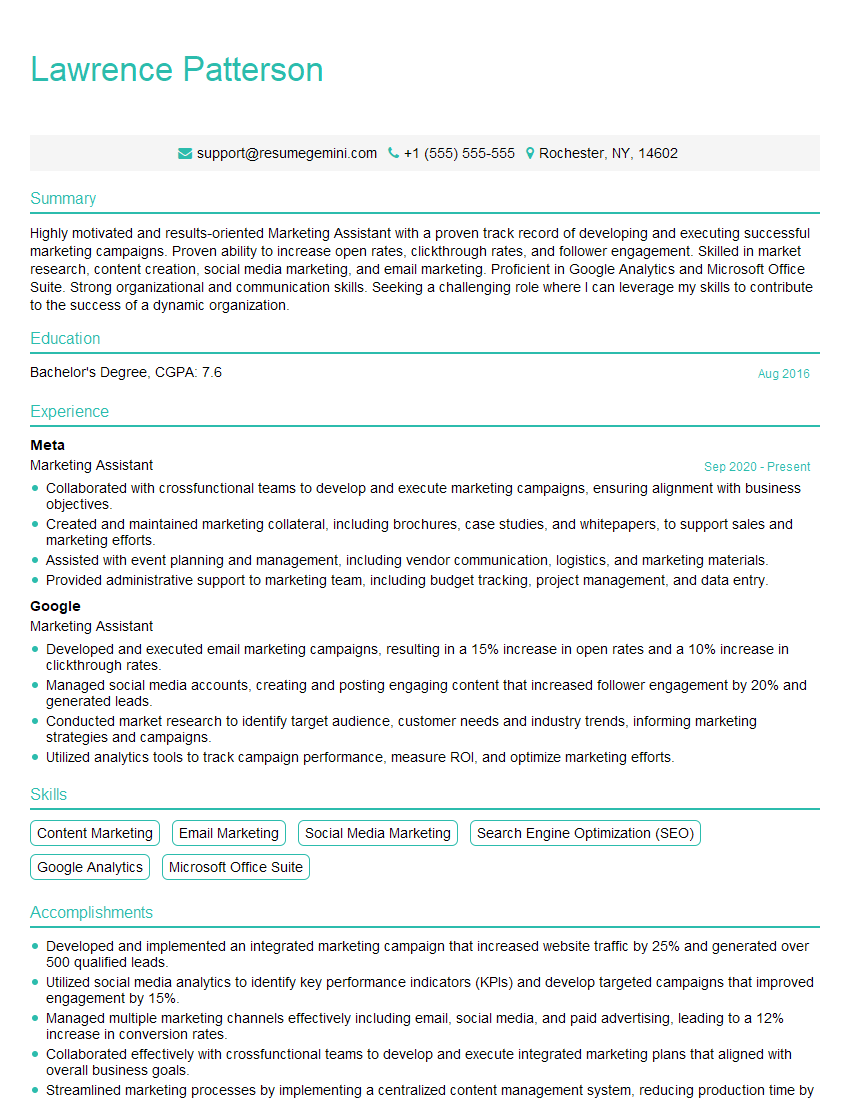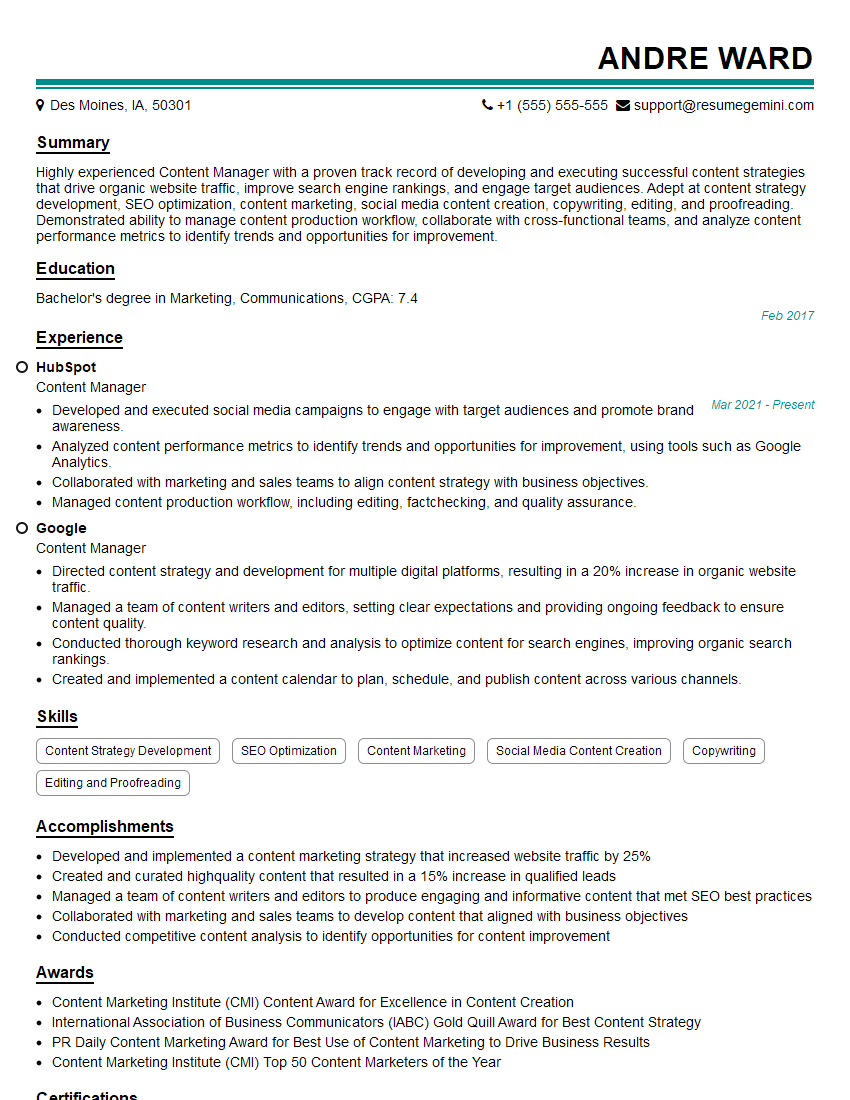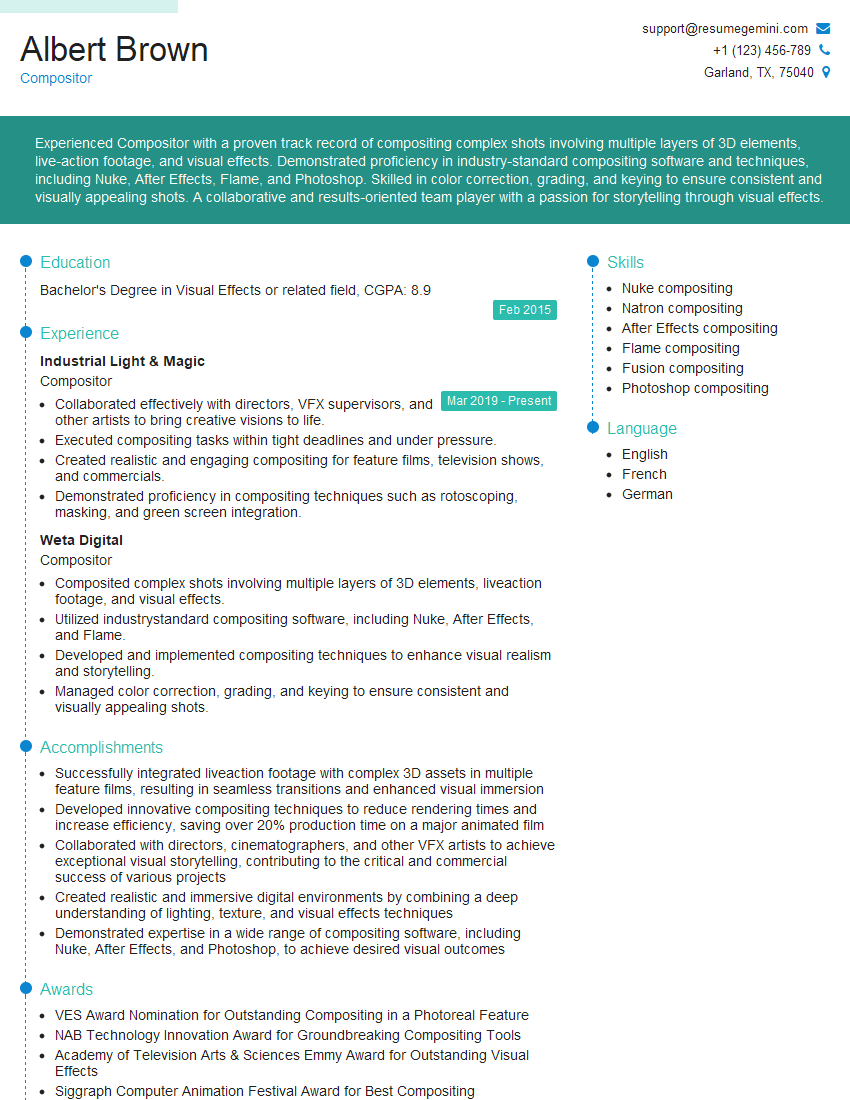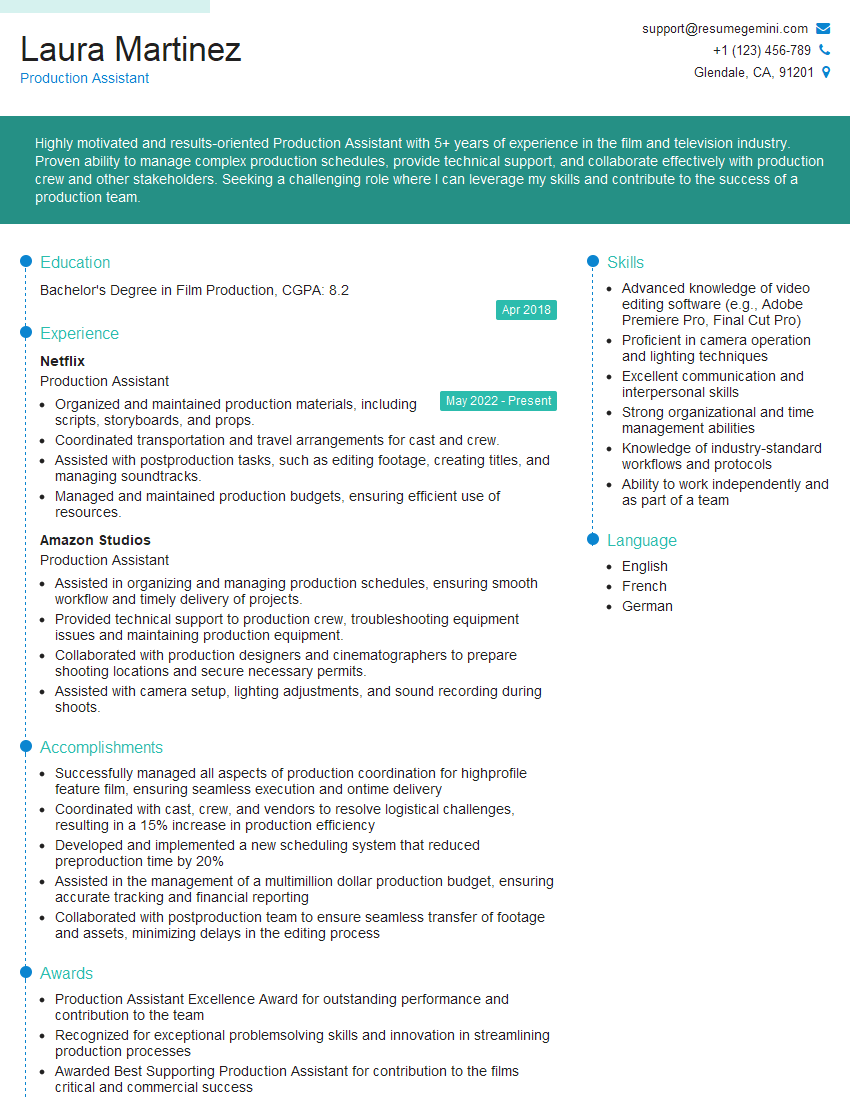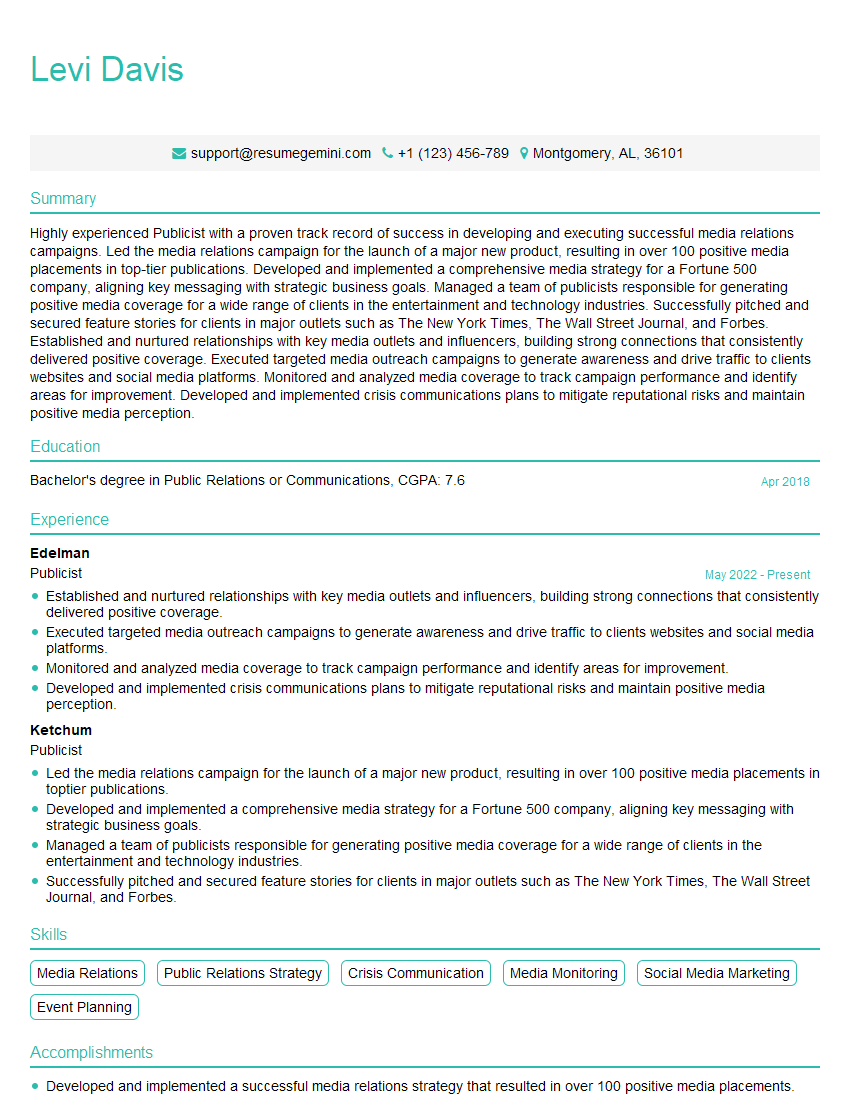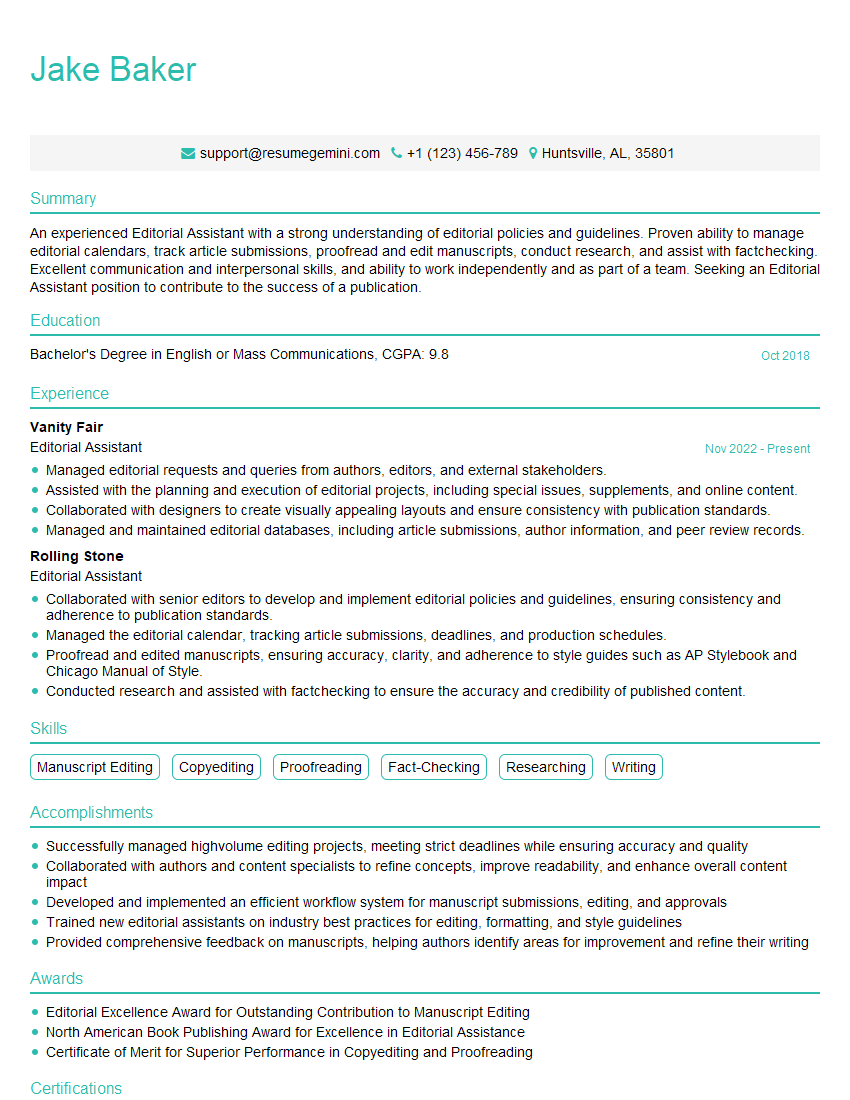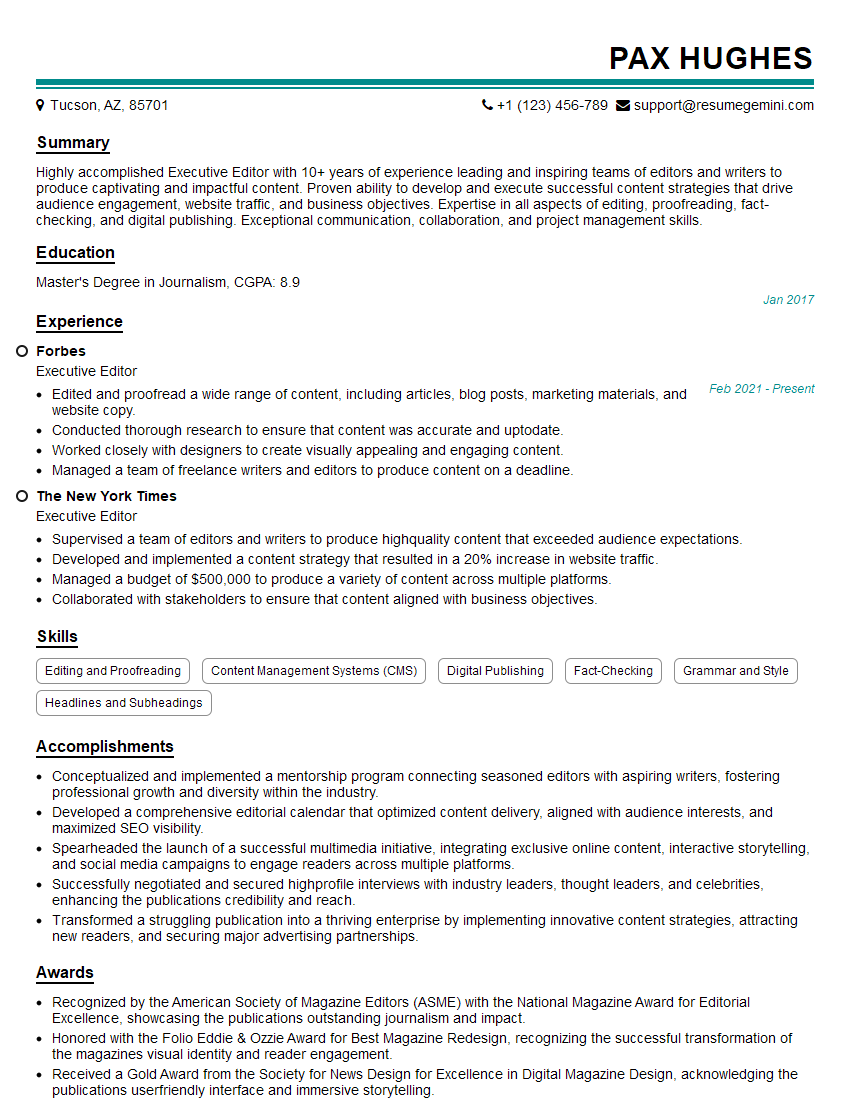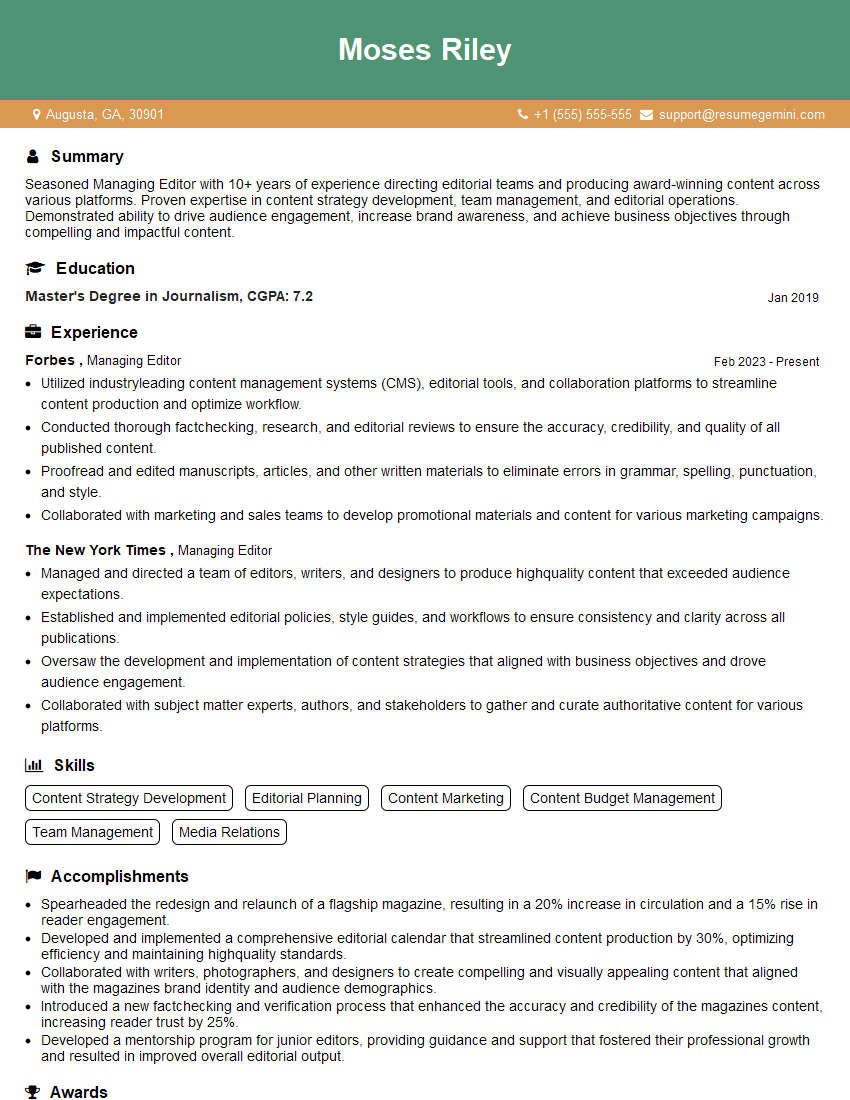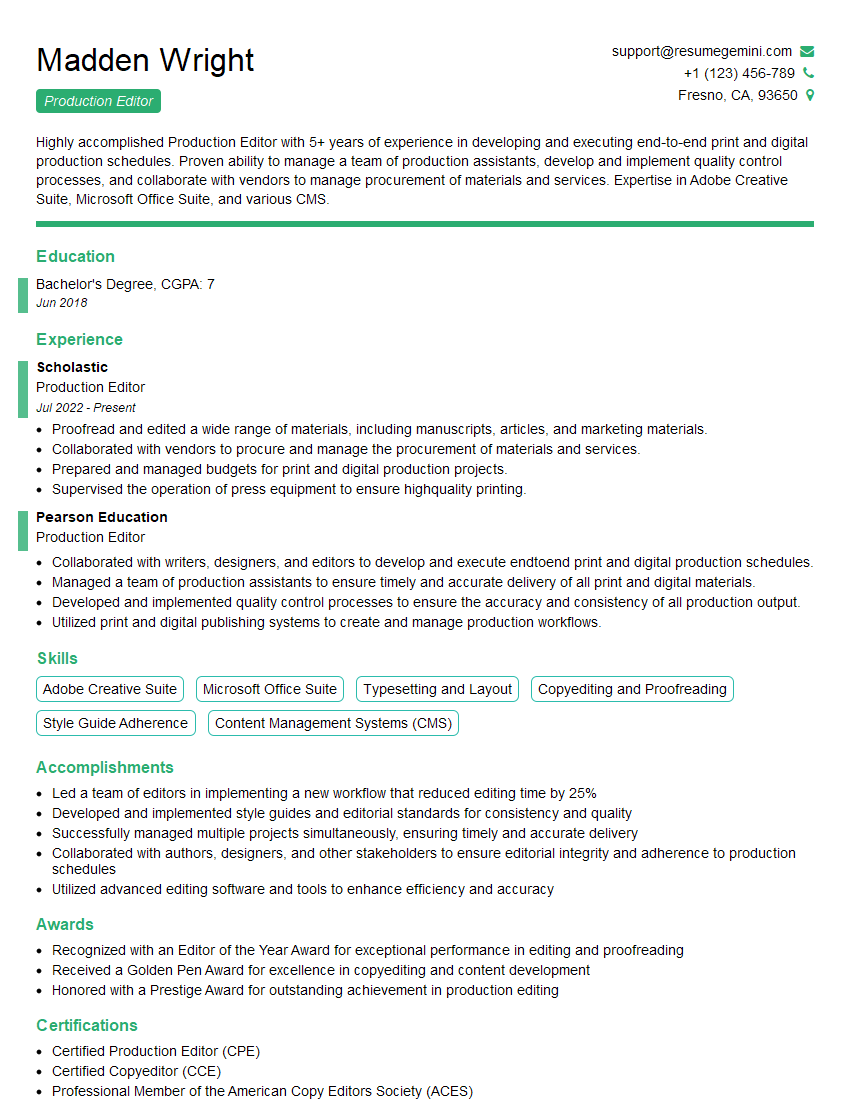Interviews are opportunities to demonstrate your expertise, and this guide is here to help you shine. Explore the essential Knowledge of Publishing Industry Best Practices interview questions that employers frequently ask, paired with strategies for crafting responses that set you apart from the competition.
Questions Asked in Knowledge of Publishing Industry Best Practices Interview
Q 1. Explain the difference between developmental editing and copyediting.
Developmental editing and copyediting are both crucial stages in the book publishing process, but they focus on different aspects of the manuscript. Think of developmental editing as the big-picture architect and copyediting as the meticulous proofreader.
Developmental editing focuses on the manuscript’s overall structure, content, and narrative. A developmental editor works with the author to improve the book’s concept, plot, character development, pacing, and overall effectiveness. They might suggest significant structural changes, offer feedback on the overall argument or theme, or help the author refine their writing style to better suit their target audience. It’s a collaborative process aiming to make the book the best it can possibly be.
Copyediting, on the other hand, is a more line-by-line process that focuses on accuracy, consistency, and clarity. A copyeditor checks for grammar, spelling, punctuation, style, and factual errors. They ensure consistency in terminology, formatting, and usage throughout the manuscript. They also might flag awkward phrasing or suggest clearer word choices. While copyeditors may offer stylistic suggestions, their primary focus remains on correctness and consistency.
Example: A developmental editor might suggest restructuring a novel’s climax for greater impact, while a copyeditor would correct grammatical errors and ensure consistency in the spelling of character names.
Q 2. Describe your experience with manuscript evaluation and assessment.
My experience in manuscript evaluation and assessment spans over [Number] years, encompassing a wide range of genres, from literary fiction and non-fiction to academic texts and children’s literature. I’ve worked with both established authors and debut novelists, providing comprehensive assessments that go beyond simple grammar checks.
My evaluation process typically includes:
- Content Analysis: Evaluating the manuscript’s overall structure, plot, character development, argumentation (if applicable), and overall coherence.
- Style and Voice Assessment: Assessing the writing style, tone, and voice to determine its suitability for the target audience and genre.
- Market Analysis: Considering the manuscript’s potential marketability, including its appeal to a specific audience and its fit within the current publishing landscape.
- Comparative Analysis: Comparing the manuscript to similar works already published to identify its strengths and weaknesses in relation to the competition.
- Technical Editing Assessment: Reviewing for clarity, grammar, style, and consistency (though this is distinct from full copyediting).
I provide detailed reports that include both constructive criticism and positive feedback, offering specific recommendations for improvement and highlighting the manuscript’s strengths. My goal is to help authors polish their work and increase their chances of publication.
Q 3. What is your familiarity with various publishing formats (print, ebook, audio)?
I’m highly familiar with various publishing formats, understanding the unique considerations and challenges each presents. My experience encompasses:
- Print: I’m proficient in working with print specifications, including page layouts, font selection, and print production processes. I understand the importance of print-ready files and the various aspects involved in ensuring high-quality reproduction.
- Ebook: I understand ebook formats (EPUB, MOBI, etc.) and their requirements. I’m aware of best practices for ebook formatting, ensuring optimal readability and functionality across different devices and e-readers.
- Audio: I’m familiar with the production process for audiobooks, including manuscript preparation, narration, editing, and mastering. I understand the importance of ensuring a compelling listening experience for the audiobook format.
My understanding of each format allows me to adapt my editing and preparation to meet the specific requirements of each platform, ensuring the highest quality and best possible reader experience regardless of the chosen format.
Q 4. How do you manage multiple projects simultaneously with tight deadlines?
Managing multiple projects simultaneously with tight deadlines requires meticulous organization and prioritization. I rely on several strategies:
- Project Management Software: I use project management tools such as [mention specific tools, e.g., Asana, Trello] to track deadlines, tasks, and progress across multiple projects. This allows me to see everything at a glance and efficiently allocate my time.
- Detailed Scheduling: I create detailed schedules for each project, breaking down large tasks into smaller, manageable steps. This allows me to stay on track and identify potential bottlenecks early on.
- Prioritization: I prioritize tasks based on their urgency and importance, focusing on the most critical aspects first. This helps ensure that the most time-sensitive projects get the attention they need.
- Communication: Clear and consistent communication with clients and collaborators is crucial. This allows for quick clarification of any issues and prevents delays.
- Time Blocking: I allocate specific blocks of time for each project, minimizing distractions and maintaining focus.
These methods allow me to work efficiently, meet deadlines consistently, and deliver high-quality work even under pressure.
Q 5. What are your preferred methods for ensuring consistent brand identity across different publishing platforms?
Maintaining consistent brand identity across different publishing platforms is crucial for building a recognizable and cohesive brand experience for the reader. My approach involves:
- Style Guides: Creating and implementing comprehensive style guides that cover everything from typography and logo usage to tone of voice and visual elements. These guides serve as a reference point for everyone involved in the publishing process.
- Template Creation: Developing consistent templates for various publishing platforms (website, social media, ebooks, print). This ensures visual consistency across all channels.
- Brand Asset Management: Centralizing and managing all brand assets (logos, fonts, images) in a centralized location to ensure everyone is using the correct and up-to-date versions.
- Regular Reviews: Conducting regular reviews of the brand’s visual and textual consistency across all platforms to identify and address any inconsistencies.
- Collaboration: Working closely with designers, marketers, and other stakeholders to ensure everyone is aligned on the brand’s visual identity and messaging.
By following these methods, I help publishers cultivate a strong, unified brand presence that resonates with their target audience, regardless of the platform they’re engaging with.
Q 6. Outline the steps involved in the book production process.
The book production process is a complex undertaking involving several key steps:
- Manuscript Preparation: This involves editing, proofreading, and formatting the manuscript to meet publication standards. This stage often includes developmental editing, copyediting, and proofreading.
- Design and Layout: The manuscript is designed and formatted for its intended format (print, ebook, audio). This includes selecting fonts, creating page layouts, and incorporating any illustrations or images.
- Typesetting: The text is set in the chosen font and layout. This step ensures the final document is visually appealing and easy to read.
- Proofreading and Correction: The typeset document undergoes a final round of proofreading to catch any errors before printing or publishing.
- Pre-Press Production: Preparing files for printing or ebook distribution, including file conversion, color correction, and quality assurance.
- Printing or Ebook Production: The book is printed or published digitally. This might involve managing the printing process or working with ebook distributors.
- Distribution and Marketing: The finished book is distributed to retailers or made available online. This stage typically involves marketing and publicity efforts.
Each step is crucial for delivering a high-quality product that meets the author’s vision and the publisher’s requirements. The process often requires collaboration between editors, designers, typesetters, printers, and marketers.
Q 7. How familiar are you with copyright law and its implications for publishing?
I possess a strong understanding of copyright law and its implications for publishing. I know that copyright protects original works of authorship, including books, and that it grants the copyright holder exclusive rights to reproduce, distribute, display, and create derivative works from their creation.
My understanding encompasses:
- Copyright Ownership and Transfer: I understand how copyright is obtained and the process of transferring copyright from the author to the publisher.
- Copyright Permissions: I’m familiar with the process of obtaining permissions for using copyrighted material, such as images, quotes, or excerpts from other works, within a publication.
- Fair Use Doctrine: I understand the limitations and exceptions to copyright, such as the fair use doctrine, which allows for limited use of copyrighted material under certain circumstances.
- Infringement and Liability: I’m aware of the potential legal consequences of copyright infringement and the importance of ensuring all material used in a publication is properly licensed or falls under fair use.
I work closely with publishers and authors to ensure that all legal requirements are met, protecting both the author’s rights and the publisher’s interests. This includes reviewing contracts, ensuring proper attribution, and managing permission requests when necessary.
Q 8. Describe your experience with working with authors and managing author relations.
Building and maintaining strong author relationships is paramount in publishing. It’s a collaborative process requiring consistent communication, understanding, and mutual respect. My experience involves working closely with authors throughout the entire publication lifecycle, from initial manuscript acquisition to marketing and promotion. This includes:
- Contract Negotiation: Carefully reviewing and explaining contract terms, ensuring fair compensation and clear expectations for both parties.
- Manuscript Feedback: Providing constructive criticism and guidance on manuscript revisions, often acting as a liaison between the author and the editorial team.
- Project Management: Keeping authors informed of deadlines, progress updates, and any potential challenges. This involves utilizing project management tools and clear communication channels.
- Marketing and Promotion: Collaborating with the author to develop a comprehensive marketing strategy, including identifying target audiences and developing engaging content.
- Conflict Resolution: Addressing potential disagreements or conflicts in a professional and timely manner, always striving to find mutually agreeable solutions. For example, I once helped resolve a disagreement between an author and the cover designer by facilitating a series of productive meetings that clarified everyone’s vision for the book’s presentation.
Ultimately, successful author relations hinge on building trust, fostering open communication, and treating each author as an individual with unique needs and perspectives.
Q 9. What is your experience with ISBNs and other book metadata?
ISBNs (International Standard Book Numbers) are crucial for book identification and tracking within the publishing industry. They are unique alphanumeric identifiers assigned to each edition and format of a book. My experience encompasses the entire ISBN process:
- ISBN Acquisition: Obtaining ISBNs from the designated national agency for each territory of publication. This involves understanding the various ISBN structures and correctly submitting necessary information.
- Metadata Creation and Management: Ensuring accurate and complete metadata for each book, including title, author, publisher, ISBN, publication date, subject categories, and more. This data is essential for distribution, online retailers, and library cataloging.
- Data Integrity: Maintaining the accuracy and consistency of metadata throughout the production process to avoid costly errors later on. Inconsistencies can lead to difficulties in distribution and sales.
- Working with Metadata Standards: Adhering to industry standards such as ONIX for data exchange and improving discoverability in online marketplaces like Amazon and Google Books.
Accurate metadata management is vital for efficient book production, distribution, and ultimately, sales. A single misplaced digit in an ISBN can disrupt the entire supply chain.
Q 10. How do you determine the target audience for a given book or publication?
Determining the target audience is a critical first step in any publishing project. It shapes every aspect of the book, from content and design to marketing and distribution. My approach involves a multi-faceted analysis:
- Content Analysis: Carefully examining the book’s content, style, and tone to identify the core themes and intended message.
- Competitive Analysis: Researching similar books in the market to understand their target audience and identify any gaps or opportunities.
- Market Research: Utilizing data from various sources, including surveys, sales data, and reader feedback, to gain insights into reader preferences and trends. For example, I’ve used social media analytics to determine what kind of content resonates with potential readers of a specific genre.
- Author Input: Collaborating with the author to understand their intended readership and their own experiences with similar books.
By combining these approaches, we create a detailed profile of the target audience, including demographics, interests, reading habits, and purchasing behaviors. This profile then informs every subsequent decision in the publishing process.
Q 11. What marketing strategies have you found most effective in the publishing industry?
Effective marketing in publishing requires a multi-channel strategy. Some strategies I’ve found most impactful include:
- Targeted Advertising: Utilizing online advertising platforms to reach specific demographics and interest groups. This may include Facebook, Instagram, or Google Ads, focusing on carefully selected keywords and demographics.
- Public Relations and Media Outreach: Securing book reviews, interviews, and features in relevant media outlets to generate publicity and build awareness.
- Social Media Marketing: Engaging with potential readers on social media platforms, building community, and generating buzz around the book. For example, creating engaging visual content or hosting author Q&A sessions on Instagram Live.
- Author Platform Leverage: Supporting the author in leveraging their own social media presence and connections to promote the book. This often includes developing engaging social media content and schedule.
- Email Marketing: Building an email list and using it to communicate directly with potential readers, providing updates, excerpts, and other enticing content.
- Influencer Marketing: Collaborating with relevant book reviewers and influencers to generate reviews and recommendations.
The most effective strategies often blend several approaches, tailoring them to the specific book and target audience. Analyzing the data from each campaign is crucial for optimizing future marketing efforts.
Q 12. Describe your experience with budget management in a publishing context.
Budget management is a critical aspect of publishing. My experience involves developing and managing budgets that encompass all aspects of the publication process, from manuscript acquisition to marketing and distribution. This includes:
- Budget Creation: Working with the editorial and marketing teams to develop a detailed budget that accurately reflects the costs associated with each stage of production. This often includes line-item breakdowns for specific tasks and anticipated expenses.
- Cost Tracking and Monitoring: Regularly tracking actual expenses against the budget, identifying any potential overruns or underspends, and making necessary adjustments.
- Financial Reporting: Providing regular financial reports to management, outlining progress against the budget and highlighting any potential issues. This may involve the use of specialized publishing accounting software.
- Negotiating Costs: Negotiating with vendors and service providers to secure the most favorable pricing for printing, distribution, and other services.
- Contingency Planning: Building contingency funds into the budget to account for unexpected costs or delays.
Effective budget management is essential for ensuring profitability and maintaining financial stability in a publishing house.
Q 13. How do you handle conflicts between editorial and production demands?
Conflicts between editorial and production demands are inevitable in publishing. My approach to resolving such conflicts involves open communication, collaboration, and a focus on prioritizing the overall project goals. This may involve:
- Clear Communication Channels: Establishing clear communication channels between editorial and production teams to ensure everyone is informed of deadlines, changes, and potential challenges. Regular meetings and consistent updates are key.
- Prioritization and Negotiation: Working with both teams to prioritize tasks, identifying potential bottlenecks, and negotiating solutions that meet the needs of both departments while minimizing disruption to the publication schedule. This often involves understanding the constraints of each department and their respective responsibilities.
- Problem-Solving and Decision-Making: Facilitating collaborative problem-solving sessions to identify solutions to conflicts and make informed decisions that benefit the entire project. This may involve proposing alternative solutions or adjustments to deadlines.
- Compromise and Collaboration: Encouraging compromise and collaboration between teams, focusing on shared goals and finding solutions that benefit both editorial and production.
Successfully handling these conflicts requires strong leadership skills, effective communication, and a willingness to find solutions that meet the needs of all stakeholders involved.
Q 14. Explain your understanding of the different stages of the publishing workflow.
The publishing workflow encompasses a series of distinct stages, each crucial for successful book production. My understanding of this workflow is comprehensive, and I have experience in managing each stage:
- Manuscript Acquisition: Identifying, evaluating, and acquiring manuscripts that align with the publisher’s goals and market demands. This includes assessing the manuscript’s quality, marketability, and potential.
- Editorial Development: Working with authors to edit and revise manuscripts, ensuring they are clear, accurate, and engaging. This can include substantive editing, copyediting, and proofreading.
- Design and Production: Overseeing the design, typesetting, and printing processes. This includes working with designers, typesetters, and printers to ensure a high-quality final product.
- Marketing and Sales: Developing and implementing marketing and sales strategies to promote the book and reach its target audience.
- Distribution: Managing the distribution of the book to retailers, wholesalers, and other channels.
- Rights Management: Managing the rights associated with the book, including foreign rights, subsidiary rights, and other licensing agreements.
A seamless workflow is key to on-time and within-budget publication. My experience in managing this complex process allows me to anticipate potential problems and effectively address them as they arise.
Q 15. What are your preferred methods for tracking progress and managing timelines?
Effective project management in publishing relies on a multi-pronged approach to tracking progress and managing timelines. I primarily utilize project management software like Asana or Monday.com to create detailed Gantt charts that visually represent the project schedule, outlining milestones, deadlines, and dependencies between various tasks. This allows for a clear overview of the entire publication process, from manuscript acquisition to final distribution.
For each stage, I establish clear, measurable, achievable, relevant, and time-bound (SMART) goals. For example, a SMART goal for the editing stage might be: “Complete all editorial revisions and incorporate author feedback by [date].” Regular status meetings with the team and the author ensure everyone is aligned and any roadblocks are identified promptly. I also use spreadsheets to track individual task completion, resource allocation, and budget adherence, providing a granular level of detail supplementing the high-level view offered by project management software. Finally, consistent communication—through email updates, progress reports, and project dashboards—keeps all stakeholders informed of the project’s health.
Career Expert Tips:
- Ace those interviews! Prepare effectively by reviewing the Top 50 Most Common Interview Questions on ResumeGemini.
- Navigate your job search with confidence! Explore a wide range of Career Tips on ResumeGemini. Learn about common challenges and recommendations to overcome them.
- Craft the perfect resume! Master the Art of Resume Writing with ResumeGemini’s guide. Showcase your unique qualifications and achievements effectively.
- Don’t miss out on holiday savings! Build your dream resume with ResumeGemini’s ATS optimized templates.
Q 16. How do you stay current with industry trends and best practices?
Staying abreast of industry trends is crucial in publishing. I actively subscribe to several key industry publications, such as Publishers Weekly and The Bookseller, to read about market changes, emerging technologies, and best practices. I also regularly attend publishing conferences and webinars, such as those hosted by the Association of American Publishers or similar organizations. Networking with colleagues at these events is invaluable for exchanging insights and learning about new approaches. Furthermore, I participate in online forums and communities dedicated to publishing professionals, engaging in discussions and sharing knowledge. This continuous learning allows me to adapt to the ever-evolving landscape of the publishing industry and refine my strategies accordingly.
Q 17. Describe a time you had to problem-solve a complex production issue.
During the production of a highly illustrated children’s book, we encountered a significant issue with the color separation process. The final printed pages showed a noticeable color shift, making some illustrations appear dull and washed out. This was a complex problem because it impacted nearly 50% of the book’s pages and was discovered just days before the print deadline. To solve this, I immediately convened a meeting with the design team, the printer, and the author. We systematically reviewed the pre-press files, identifying a mismatch in the color profiles used during the different stages of production. The printer confirmed they were using the incorrect profile. We then implemented a rapid fix: the design team meticulously corrected the color profiles in the affected files, creating new color-separated plates. The printer expedited the printing process, prioritizing the corrected plates, resulting in minimal delay. This experience underscored the importance of thorough quality control at each production stage and the necessity for clear communication across the entire production chain. It also highlighted the value of having strong relationships with suppliers who can help find solutions under pressure.
Q 18. How do you assess the marketability of a manuscript?
Assessing a manuscript’s marketability requires a holistic approach, going beyond simply evaluating the writing quality. First, I consider the manuscript’s genre and target audience, identifying its potential market size and competitive landscape. I research similar titles that have been successful, analyzing their sales figures, marketing campaigns, and overall reception. This allows me to gain insight into the demand for the type of book being proposed. Next, I evaluate the manuscript’s unique selling proposition (USP)—what makes it stand out from the competition. Does it offer a fresh perspective, a unique voice, or a compelling story? A strong USP is crucial for attracting readers and distinguishing it in a crowded market. Finally, I consider the author platform and marketing potential. Does the author have a significant online presence or a large, engaged following? This can significantly impact initial sales and long-term success. The combination of market research, USP analysis, and author platform assessment provides a comprehensive view of the manuscript’s marketability and potential for success.
Q 19. What are your skills in using publishing software (e.g., InDesign, QuarkXPress)?
I’m proficient in Adobe InDesign and have worked extensively with QuarkXPress in the past. InDesign is my primary tool for page layout and design, and I’m comfortable creating complex layouts, managing typography, and incorporating images and illustrations. I understand the intricacies of document preparation for print and digital distribution, including utilizing styles, master pages, and creating linked files to maintain consistency and facilitate efficient updates. My expertise extends to creating print-ready files adhering to industry standards, such as utilizing CMYK color profiles for print and RGB for digital formats. While I’m less frequently using QuarkXPress now due to InDesign’s industry dominance, I have a strong foundation in both and can quickly adapt to different software depending on project needs. My skills allow me to handle a wide range of publishing tasks from designing book covers to formatting complex academic texts.
Q 20. Explain your understanding of print-on-demand and other printing methods.
Print-on-demand (POD) is a revolutionary printing method that allows publishers to print books only when ordered. This eliminates the need for large print runs and storage costs, making it ideal for low-volume books or those with niche audiences. POD significantly reduces risk, as publishers avoid being stuck with unsold inventory. Traditional printing methods, on the other hand, involve large print runs with a higher upfront investment. This is best suited for books with high anticipated demand, where volume discounts offset the greater financial risk. Other methods include digital printing, which offers greater flexibility and shorter turnaround times than traditional offset printing but may have higher per-unit costs, and offset printing, which remains the most cost-effective option for large-scale print runs. The choice of printing method depends heavily on factors such as book length, anticipated sales, budget, and turnaround time required.
Q 21. How do you manage author expectations regarding publication timelines and sales projections?
Managing author expectations is a critical aspect of the publishing process. From the outset, I establish clear, realistic timelines and sales projections, supported by thorough market research. I explain the various stages of production, highlighting potential delays and their reasons. Open communication is paramount—I regularly update authors on progress, addressing any concerns promptly and transparently. Instead of providing overly optimistic sales predictions, I base my projections on comparable titles and market data, ensuring a realistic expectation of sales performance. I also emphasize the importance of marketing and author participation in promotional activities to boost sales. By maintaining transparent communication and setting realistic expectations, I build trust and foster a productive author-publisher relationship. This approach minimizes potential misunderstandings and maintains a healthy working relationship throughout the publication journey.
Q 22. How do you approach quality control and proofreading?
Quality control and proofreading are the cornerstones of successful publishing. My approach is multi-layered, starting well before the manuscript reaches the final stages. It begins with a thorough review of the manuscript during the acquisition process, identifying potential issues early on. This proactive approach saves significant time and resources later.
My proofreading process involves multiple stages. First, I perform a comprehensive developmental edit, focusing on the manuscript’s overall structure, clarity, and consistency. Next, a copyedit addresses grammar, style, punctuation, and factual accuracy. Finally, a meticulous proofread catches any remaining typos, inconsistencies, and formatting errors before the final print or ebook production. I use style guides such as the Chicago Manual of Style to ensure consistency and accuracy. I also employ technology like grammar and style checkers (but never solely rely on them), supplemented by multiple rounds of human review.
For example, during a recent project, early identification of a significant factual inaccuracy in the manuscript saved extensive revision later, enhancing the book’s credibility and avoiding costly corrections.
Q 23. Describe your experience with digital rights management (DRM).
Digital Rights Management (DRM) is crucial for protecting intellectual property in the digital publishing landscape. My experience encompasses various DRM technologies, including those used by major ebook retailers like Amazon and Apple. I understand the implications of different DRM systems on accessibility, user experience, and piracy prevention. I’ve worked with publishers to implement appropriate DRM based on their specific needs, target audience, and the nature of the content.
For instance, I’ve helped a publisher weigh the advantages and disadvantages of using different DRM approaches – some offering strong protection but potentially hindering accessibility for users with disabilities, while others provided less robust protection but better user experience. Choosing the right balance requires a deep understanding of the marketplace and the potential risks.
Q 24. How do you work effectively with freelance editors and designers?
Effective collaboration with freelance editors and designers is paramount. I establish clear communication channels from the outset, using project management tools like Asana or Trello to track progress, deadlines, and feedback. Detailed style guides and briefs are provided, outlining expectations and ensuring consistency. Regular check-ins and open feedback loops foster a collaborative environment.
I prioritize building strong working relationships based on trust and mutual respect. I believe in clear, respectful communication, providing constructive criticism and celebrating successes. A recent project involved collaborating with a designer remotely; using cloud-based sharing tools and regular video conferences ensured a smooth and efficient process.
Q 25. Explain your understanding of different publishing contracts.
Publishing contracts are complex legal documents defining the relationship between authors and publishers. I am familiar with various contract types, including:
- Traditional Publishing Contracts: These grant the publisher exclusive rights to publish the work in exchange for an advance and royalties based on sales.
- Subsidy Publishing Contracts: The author pays the publisher for publishing services, and the author retains copyright.
- Self-Publishing Contracts: The author retains full control and bears all publishing costs. Many self-publishing platforms offer various services to authors with flexible pricing options.
- Hybrid Publishing Contracts: These combine elements of traditional and self-publishing, often involving a mix of author investment and publisher services.
Understanding the nuances of these contracts, including clauses concerning rights reversion, royalties, territories, and durations, is essential to navigate the publishing landscape successfully. I advise authors to carefully review contracts with legal counsel before signing.
Q 26. What metrics do you use to measure the success of a publishing project?
Measuring the success of a publishing project involves considering various metrics. These go beyond just sales figures. I look at:
- Sales figures: Total units sold, revenue generated.
- Marketing reach: Website traffic, social media engagement, reviews.
- Critical reception: Reviews from professional critics and readers.
- Audience engagement: Reader interaction and feedback.
- Brand impact: Increased awareness and reputation of the author and publisher.
For example, a book might not have blockbuster sales but could still be considered successful if it achieves significant critical acclaim, establishing the author’s reputation and leading to future opportunities.
Q 27. How do you handle negative reviews or criticism of a publication?
Handling negative reviews or criticism requires a professional and measured response. Ignoring them is never the answer. Instead, I analyze the criticism, focusing on constructive feedback. A thoughtful response, acknowledging concerns while maintaining professionalism, can show engagement and build trust.
For instance, if a reviewer criticizes a factual inaccuracy, we would investigate and potentially address it in future editions. If the criticism is subjective, we might politely acknowledge the reader’s different perspective. Overly aggressive or inappropriate comments should be addressed responsibly, potentially by blocking or reporting, but focusing on engagement with constructive criticism.
Q 28. Describe your experience with international rights and foreign markets.
Experience with international rights and foreign markets involves understanding different cultural contexts, translation requirements, and legal frameworks. I’ve worked with publishers to secure foreign rights for books, coordinating translations, and adapting materials for different markets. This involves navigating copyright laws across different territories and working with foreign publishers and translators.
For example, a recent project involved negotiating translation rights for a book in several European languages. This required understanding the specifics of each country’s publishing industry and ensuring proper contract terms were in place. It’s crucial to select translators with specific expertise and cultural understanding to accurately convey the original work’s meaning and tone.
Key Topics to Learn for Knowledge of Publishing Industry Best Practices Interview
- Copyright and Intellectual Property: Understanding copyright law, licensing agreements, and ethical considerations in publishing.
- Manuscript Evaluation and Development: Assessing manuscript quality, providing constructive feedback, and guiding authors through the editorial process.
- Production and Pre-press: Familiarity with file formats, printing processes, and the stages involved in preparing a book for publication.
- Marketing and Sales Strategies: Understanding different marketing channels, target audience identification, and sales projections.
- Industry Trends and Technologies: Staying abreast of current trends in publishing, including digital publishing, self-publishing, and emerging technologies.
- Project Management in Publishing: Managing timelines, budgets, and teams effectively throughout the publishing process. This includes problem-solving skills related to unexpected delays or budgetary constraints.
- Contract Negotiation and Management: Understanding author contracts, subsidiary rights, and royalty structures.
- Metadata and Cataloging: Understanding the importance of accurate metadata for discoverability and searchability of published works.
- Digital Rights Management (DRM): Knowledge of different DRM strategies and their implications for protecting intellectual property.
Next Steps
Mastering Knowledge of Publishing Industry Best Practices is crucial for career advancement in this dynamic field. A strong understanding of these principles will significantly improve your interview performance and open doors to exciting opportunities. To enhance your job prospects, focus on creating an ATS-friendly resume that showcases your skills and experience effectively. ResumeGemini is a trusted resource to help you build a professional and impactful resume. We offer examples of resumes tailored to Knowledge of Publishing Industry Best Practices to guide you. Let ResumeGemini help you present yourself as the ideal candidate.
Explore more articles
Users Rating of Our Blogs
Share Your Experience
We value your feedback! Please rate our content and share your thoughts (optional).
What Readers Say About Our Blog
Hi, I’m Jay, we have a few potential clients that are interested in your services, thought you might be a good fit. I’d love to talk about the details, when do you have time to talk?
Best,
Jay
Founder | CEO




